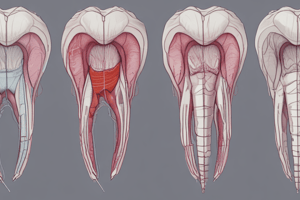Podcast
Questions and Answers
What stage marks the formation of the dental lamina?
What stage marks the formation of the dental lamina?
- Bell Stage
- Bud Stage
- Initiation Stage (correct)
- Cap Stage
What does the enamel organ form?
What does the enamel organ form?
Enamel
The dental papilla forms the dentine and pulp complex.
The dental papilla forms the dentine and pulp complex.
True (A)
During which stage does the tooth germ form 10 buds in each dental arch?
During which stage does the tooth germ form 10 buds in each dental arch?
The __________ is a protective barrier to the enamel organ.
The __________ is a protective barrier to the enamel organ.
Name the four different types of cells that develop in the enamel organ during the bell stage.
Name the four different types of cells that develop in the enamel organ during the bell stage.
What happens during the late bell stage?
What happens during the late bell stage?
Nerve supply is rich around the dental follicle during tooth development.
Nerve supply is rich around the dental follicle during tooth development.
What is the role of the cervical loop?
What is the role of the cervical loop?
Study Notes
Stages in Tooth Development
- Tooth development progresses through distinct stages: Initiation, Bud, Cap, Bell, Appositional, and Maturation.
- Each stage marks a critical phase in the formation and differentiation of dental structures.
Initiation Stage
- Oral epithelium cells proliferate, forming a thick band known as primary epithelial bands or odontogenic epithelium.
- Basement membrane separates the ectodermal oral epithelium from arising ectomesenchyme.
- Induction processes involve cellular interactions crucial for tooth formation.
Bud Stage
- Formation of localized thickening termed placodes followed by extensive proliferation to develop into buds corresponding to future deciduous teeth.
- Each dental arch (maxillary and mandibular) has 10 buds, leading to ectomesenchyme condensation.
- The basement membrane remains between the bud and ectomesenchyme, essential for proper tooth development.
Cap Stage
- Continued proliferation leads to unequal growth and initiation of cell differentiation.
- Completion results in the formation of ten tooth germs in each arch, constituting primary dentition.
- Tooth germ components include:
- Enamel organ: Ectodermal cells forming enamel.
- Dental papilla: Condensed ectomesenchyme forming pulp and dentine.
- Dental follicle/dental sac: Surrounding ectomesenchyme forming the supporting structures (cementum, periodontal ligament, alveolar bone).
Bell Stage
- Four types of cells develop within the enamel organ:
- Outer enamel epithelium (OEE): Provides a protective barrier.
- Stellate reticulum (SR): Star-shaped cells supporting enamel production.
- Stratum intermedium (SI): Layer aiding in enamel production.
- Inner enamel epithelium (IEE): Columnar cells differentiating into ameloblasts that secrete enamel.
- Vascular supply includes clusters of blood vessels around the dental follicle, while a rich nerve plexus forms around the tooth germ.
Late Bell Stage
- Dental lamina fragments separate developing buds from the oral epithelium; some epithelial cells may degenerate or become epithelial pearls.
- The tooth crown assumes its final shape as IEE completes its folding and mapping of the crown.
- The cervical loop marks where inner and outer enamel epithelia meet.
Apposition Stage
- Inner enamel epithelial cells are involved in the secretory activities leading to enamel formation, cumulatively contributing to the ongoing development of the tooth structure.
Maturation Stage
- Focuses on functional development of the tooth, including the development and integration of supporting structures.
Studying That Suits You
Use AI to generate personalized quizzes and flashcards to suit your learning preferences.
Related Documents
Description
This quiz covers the essential stages in tooth development, including initiation, bud, cap, bell, appositional, and maturation stages. It will help you understand the progression from dental lamina to crown and root formation, providing a comprehensive overview of dental anatomy and development.




